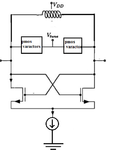hanikapa
Member level 4
Hi,
I have the measurement results for an LC-VCO which is working at 2GHz and the design is based on conventional structures. The measured phase noise is -90dBc/Hz but the simulated phase noise using RC extracted design is -110dBc/Hz. Does anybody have experience that why the phase noise is much worse?
- - - Updated - - -

The above picture is the structure for the designed VCO
I have the measurement results for an LC-VCO which is working at 2GHz and the design is based on conventional structures. The measured phase noise is -90dBc/Hz but the simulated phase noise using RC extracted design is -110dBc/Hz. Does anybody have experience that why the phase noise is much worse?
- - - Updated - - -

The above picture is the structure for the designed VCO